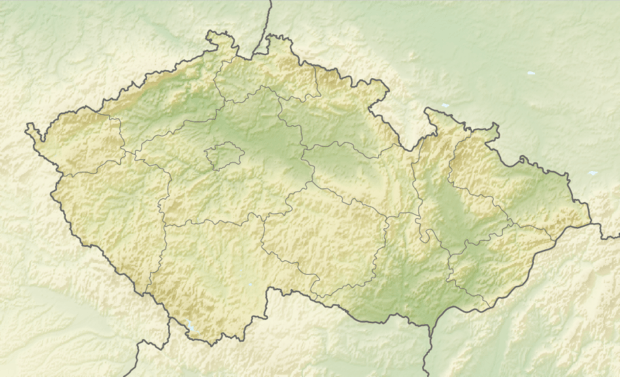Hostouň (Domažlice District)
Hostouň (German: Hostau) is a town in the Domažlice District in the Plzeň Region of the Czech Republic. It has about 1,300 inhabitants.
Hostouň | |
|---|---|
Town | |
Church of Saint James, the Elder | |
_Flag.jpg) Flag  Coat of arms | |
 Hostouň Location in the Czech Republic | |
| Coordinates: 49°33′38″N 12°46′15″E | |
| Country | |
| Region | Plzeň |
| District | Domažlice |
| First mentioned | 1247 |
| Government | |
| • Mayor | Miroslav Rauch |
| Area | |
| • Total | 38.5 km2 (14.9 sq mi) |
| Elevation | 432 m (1,417 ft) |
| Population (2020-01-01[1]) | |
| • Total | 1,318 |
| • Density | 34/km2 (89/sq mi) |
| Time zone | UTC+1 (CET) |
| • Summer (DST) | UTC+2 (CEST) |
| Postal code | 345 25 |
| Website | www |
The town is located on the outskirts of the Upper-Palatinate Forest at the upper Radbuza, and on the railway track between Domažlice and Tachov.
Administrative parts
Adminitsrative parts of Hostouň are: Babice, Holubeč, Horoušany, Mělnice, Mírkovice, Přes, Skařez, Slatina, Štítary, Svržno and Sychrov.
History
In 1238 the village was firstly mentioned in written records as a property of Gumpert of Hostouň. His descendants who ruled the area till the 15th century also processed the Palatinate town of Schönsee.
During the Hussite Wars Citbor of Wolfstein, a supporter of Imperator Sigismund, was ruling in Hostouň. When the reign of the noble families of Wolfstein and Rabenstein came to an end the Dominion of Hostouň was taken over by the Lords of Guttenstein. In 1522 the village under Georg of Guttenstein was granted the right to hold markets. In 1587 Imperator Rudolf II awarded Hostouň the rank of a town and a coat of arms: A stannous wall with an open gate, above the wall two towers, between these a tripartite hatchment with a back deer head, a crowned lion and below a red area. Additionally in 1587 the town was granted to hold two other fairs and a horse market besides the annual Saint-James-Market as well.
During the reformation Hostouň was temporarily Protestant. As a consequence of the Battle at the White Mountain the property of the Guttensteins was confiscated. The dominion was sold to Zdenko of Mitrowitz (1622), after a short period retailed to the family of Czernin and even in 1656 to the Counts of Trauttmansdorff-Weinsberg, who put their dominions Bischofteinitz and Hostouň together.
Since 1805 Hostouň was seat of a deanery. The church of Saint James the Elder, since 1384 mentioned as a parish, was remodelled in baroque style in 1731 and rebuilt after the great fire in 1877. An in wood carved madonna derives from the first half of the 15th century and is adored as the "Shrine of the Sorrowful Mother of God of Hostouň".
In 1915 an imperial military stud of Galicia and Bukowina was transferred to Hostouň. During the World War II parts of the famous Lipizzaner horses of the Spanish Riding School in Vienna were stationed in Hostouň. The stud's administrative offices had been housed in the former castle of the Prince of Trauttmansdorff in Hostouň. After the end of the World War II the Lipizzaner horses had been rescued by an adventures attempt of German and American soldiers.
Since the 16th century a continuing inflow of German inhabitants could have been realized. From 1938 to 1945 it was one of the municipalities in Sudetenland. In 1946 the Germans still were the major ethnic group. In 1930 the population of Hostouň counted 1,048 inhabitants – 160 Czechs, 8 foreigners and 880 German(-Bohemians). After the expulsion of the German population Hostouň only had 630 inhabitants in 1947. In addition Hostouň lost the rank of a town, finally got it back in 2006.
Points of interest
- Sanctus Jacobus Major was mentioned in written records firstly in 1384 (In Decanatu Horsoviensi et in Archidiaconatu Horsoviensi). In 1731 the church was remodelled in baroque style and was created a deanery in 1805.
- The Assumption Chapel (Assumptio Beatae Mariae Virginis) was built in 1936 as a chapel for the cemetery by Susanna Kleinschmidt's donation.
- The Corpus Christi Chapel was erected by the donation of Countess Kordula of Chudenitz honouring the miracle of consecrated hosts in Hostau during the 14th century. In 1805 the chapel was removed due its decrepit conditions.
- The baroque rectory of the 18th century was rebuilt after the great fire in 1877, by which altogether 43 homes had been destroyed.
- The princely castle of the Trauttmansdorff family was built as a triangle and was a hunting lodge, later the seat of the widow, Princess Anne of Trauttmansdoff-Weinberg. From 1916 on the castle was used as a military stud, then from 1918 as a regular stud. In the years 1942 to 1945 the Lipizzaner horses of the Spanish riding school were stationed here. Since 2004 the castle is a juvenile jail.
Twin towns – sister cities

References
- "Population of Municipalities – 1 January 2020". Czech Statistical Office. 2020-04-30.
- "Historie města Hostouň". hostoun.cz (in Czech). Město Hostouň. Retrieved 2020-08-05.
External links
| Wikimedia Commons has media related to Hostouň (Domažlice District). |